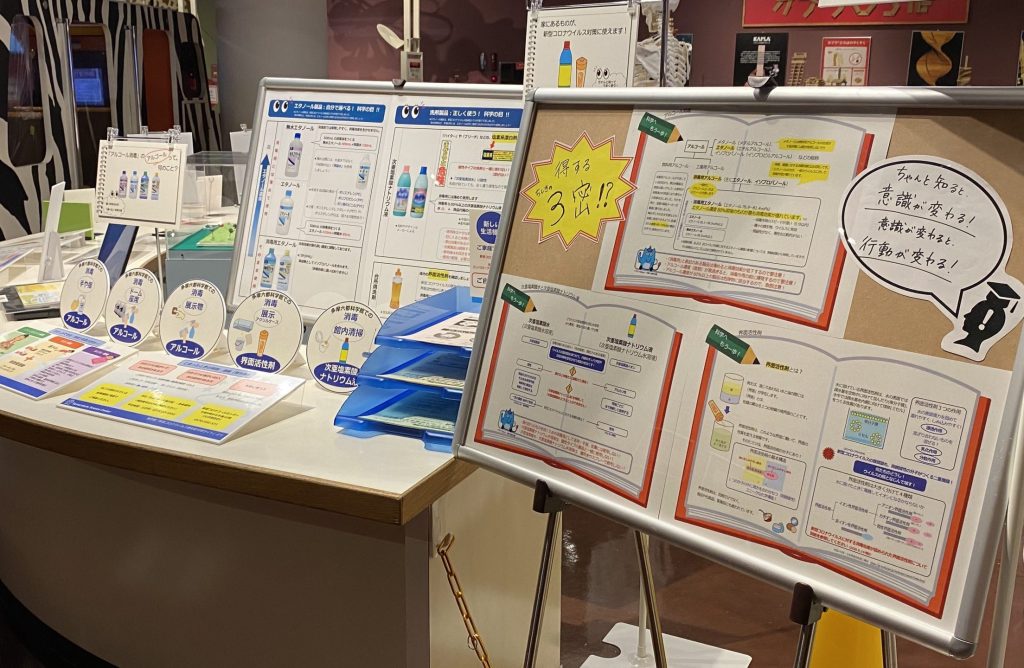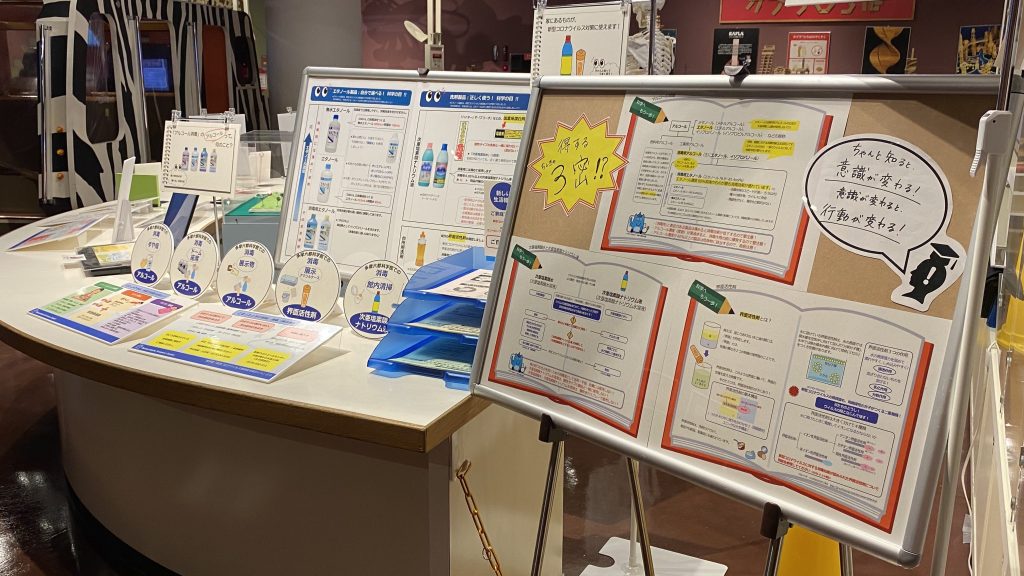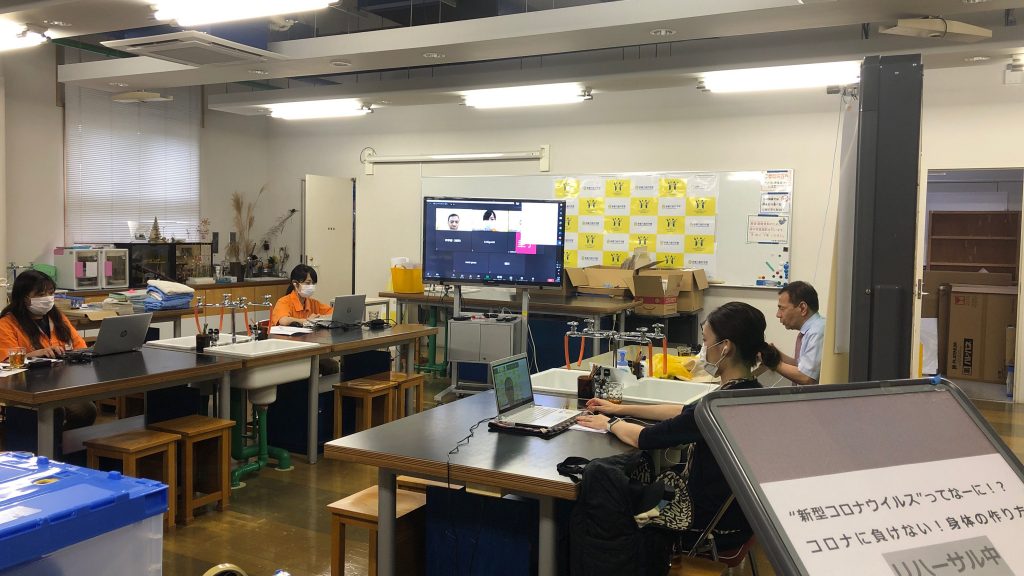
August 28, 2021
Activity of a science museum in the pandemic and ways of conveying information on infectious diseases: Focusing on a Case of Tamarokuto Science Center
Hiromi TAKAO
Research and Education Group Leader,
Tamarokuto Science Center
1. Introduction
The Tamarokuto Science Center (“the Center”) was closed for 93 days from February 29 to May 31, 2020, following the response of Tokyo Metropolitan public schools and other organizations to the request issued by the 15th meeting of the Novel Coronavirus Response Headquarters on February 27, 2020. The Center, which was founded by the Tamarokuto Science Center Association, opened in 1994 as a science museum for the six cities[1] located in the Northern Tama area of Tokyo. Since the designated management system introduction in 2012, NOMURA Co., Ltd. has been in charge of operations. As an independent science museum, the Center’s response to COVID-19 has been managed according to evidence-based guidelines that were established by the founding organization. In this article, focusing on the case of the center, I would like to discuss the activities and their challenges that science museums have undertaken during the pandemic.
2. Science museum activities during the temporary closure period
Many facilities across Japan utilized the Internet to provide information during the three-month temporary closure, mainly by posting original content on their official websites and social media. On their website, the Japan Science Museum Association posted a section titled, “Sharing activities during the novel coronavirus restrictions,” which introduces content created by 26 member museums[2]. Many of these examples are videos of experiments and crafts that are easy to try at home, videos of science shows, and explanatory information on exhibits. Since many science museums focus on education rather than on research activities, most of their content makes use of their educational activities. For example, the Hamamatsu Science Museum shared a special series of 80 videos titled “Mirai-ra at Home,” which were posted daily on their official YouTube channel from March 3 to May 31[3].
At the Center, we launched a special webpage called “Enjoy the science center at Home” on April 16 while most of our staff were working from home. During the temporary closure, staff of the Center’s Research and Education Group, Astronomy Group, and Interpreter Team created 235 new content items—including explanations of exhibits, astronomy, crafts, and experiments—based around the two themes of “Science Museum Visit at Home” for everyone unable to visit the museum, and “Do Science at Home!”[4] for those who wanted to try their own activities at home. In particular, regarding the exhibit explanations, we aimed to have the staff improve their own skills and knowledge as they enriched the permanent exhibits, as they were not able to be on site during this period. Overall, it was an opportunity for each staff member to take on different challenges than they would normally face during ordinary times. The Astronomy Group, for instance, not only provided information on stars in the sky, but also released “the Morning Activity: 12 Constellations Coloring Book” to help children maintain their rhythm of life during this period. In addition, we set up a special project called the “Science Bookshelf,” through which all staff and volunteers introduce science-related books.
3. Reopening permanent and special exhibitions and resuming program activities
During the temporary closure, I and four volunteer staff from science museums across Japan conducted two questionnaire surveys targeted at science museums on the situation before and after the museums were reopened in May and July [5]. I would like to introduce some of the results we obtained, which reveal what the situation was like at the time. Regarding hands-on exhibits, which are overwhelmingly more common in science museums than in other types of museums, more than 80 percent of respondents answered that they were restricted in May before reopening, and less than 70 percent responded that they were restricted in July after reopening. The restricted items were touchscreen monitors, puzzles, and other touch-based items, exhibits involving vocalization, peek-inside exhibits that pose a risk of eye contact, and sound-related exhibits that require ventilation measures (because they are enclosed spaces). About half of the respondents also decided to close off sections for young children and other exhibits that are difficult to disinfect. Infections have been found to spread through droplets of saliva and stool. To prevent infections from spreading, museums must discuss and establish guidelines on how to open their facilities to the public with the understanding and cooperation of their users while reducing the risk of infection by eliminating the “Three Cs” (closed spaces, crowded places, and close-contact settings), enforcing mask wearing, hand disinfection, and body temperature checks, obtaining users’ contact information, and thoroughly disinfecting the inside of the museum.
Many science museums also include planetariums, facilities unique to this genre of museum. Museums could choose to suspend or continue planetarium operations; in the latter case, facilities took measures such as limiting the number of visitors or shortening the frequency and duration of screenings. Since this directly affects revenue obtained through viewing fees, many facilities are operating at significant losses. In addition, most planetariums and exhibitions continue to perform disinfection work, although the frequency varies by facility. In the July survey, half of the facilities responded that floor staff or other available staff were in charge of the disinfection work. This indicates that staff at facilities where the work cannot be outsourced to cleaning companies are being forced to perform work that differs from their original duties.
At the Center, we implement the following countermeasures against the “Three Cs” on site: 1) we create and adopt our own guidelines for droplet infection countermeasures and management of staff and users’ physical conditions; 2) for all rooms, including permanent exhibition rooms, the planetarium, and rest areas, we determine the maximum number of people who can stay in each room at the same time while ensuring proper ventilation and sufficient distance between users, and manage room occupancy on this basis; 3) all staff regularly disinfect exhibits and the planetarium regardless of their team affiliation; 4) we close off exhibits that are difficult to disinfect and exhibits that, due to their layout, do not allow for sufficient distance to be maintained between people (in other families)[6] ; and 5) we shorten the hours, reduce capacity, move online, and suspend lab programs and educational programs[7]. As of September, volunteer activities have been suspended after we discussed the issue with the volunteer association.
Regarding our educational programs, those that comply with the above measures were gradually resumed from July. In addition, a quiz program for elementary school students and a lecture on the novel coronavirus, which I will discuss later, were held as online programs. Since September, we have been conducting lectures and other postponed events in collaboration with outside organizations via livestream on platforms such as Zoom and YouTube.
As for our special exhibitions, we held “the Rokuto Exercise Science Park: Experiment with your body, understand with your head!” exhibition during the summer vacation. We had originally planned to hold this exhibition as a special spring exhibition, but since it was structured around hands-on exhibits, we had to rearrange the exhibits, make a disinfection plan, and implement capacity limits, a time-slot system, and age restrictions to ensure the safety of participants and staff. Since families (siblings, including preschoolers, and their parents) constitute the Center’s main group of users, the number of users fell significantly to 2,130 people, or 70% of the participant capacity, since the families could not participate together. As the Center has always emphasized creating a space where anyone can participate at any time, this turnout once again brought to light the challenges of operating during the pandemic.
4. Educating the public about COVID-19 from a scientific perspective
Among history-focused museums, some facilities collect and exhibit objects related to COVID-19 alongside relevant information[8]. On the other hand, it can be said that the original role of science museums is to provide citizens with information from a scientific perspective in addition to such social information. However, at science museums in Japan, there are still only a few examples of exhibitions and events themed around the novel coronavirus.

In Japan, one museum that began providing information on the novel coronavirus at a relatively early stage was the Miraikan. In mid-March, they released “Facts about Coronavirus Disease 2019, COVID-19 and the Novel Virus” as a free online resource[9]. Because this high-quality data was distributed to anyone who wanted it, I saw panels displaying the same information at several other facilities. From April, the museum also provided information on the novel coronavirus through the Miraikan’s Niconico Live broadcast, “Facts about the Novel Virus,” on weekdays during the temporary closure[10]. Another museum is the Kochi MIRAI Science Center, which held a special exhibition titled “A Science Museum Presents the ‘New Coronavirus’ from an Easy-to-Understand Scientific Perspective” from May 13 to the end of August, and has released five explanatory videos on YouTube[11].
From mid-March, staff at the Center in charge of the “Body & Senses” exhibition room began gathering information on COVID-19 and considering about how present it. The result is a special exhibition “How to Deal with the Novel Coronavirus: Let’s learn correctly about the body and viruses!”[12] as well as an online event via Zoom held to coincide with the Center’s reopening. The great help of Professor Fumiyoshi Ishii and members of his Self-Medication Research Lab at Meiji Pharmaceutical University made planning and supervision of these events possible. They have been conducting research in cooperation with the Center for several years, with the aim of promoting the health of citizens in the Northern Tama area.


(1) Special Exhibition: How to Deal with the Novel Coronavirus: Let’s learn correctly about the body and viruses!
The initial exhibition consisted of basic information about the novel coronavirus, biological defense mechanisms, testing methods, and prevention methods. We later focused on disinfection and added information about differences in the components of each drug, their functions, and how to use them. Since it is the Center’s staff who carry out disinfection work on the exhibit items and inside the planetarium, we also introduce the actual disinfectant we use. In fact, this exhibit was partially inspired by an incident that occurred in which using an unsuitable chemical agent in the initial stages of disinfection work damaged an acrylic display case. We distributed some of the exhibit information in printed form, and by the end of August, we had passed out approximately 3,650 copies to visitors. This exhibit is currently ongoing and still being updated with additional information.
(2) Online Lecture: What is the ‘Novel Coronavirus’?! Don’t Lose to COVID! A Zoom lecture on building up your body
This online event took place on June 20 with the theme of “boosting immunity to build up a body that resists infection by COVID-19.” Since this was the first time for both the Center and Meiji Pharmaceutical University’s Self-Medication Research Lab to attempt an event over Zoom, we prepared for it carefully by holding several rehearsals, including obtaining the cooperation of about 30 inactive volunteers as mock viewers.
The event consisted of a lecture and questions on “viruses and immunity,” which are important to learn about during this time, and “self-medication that each individual can do on their own,” even in an environment that puts their health at risk. There were 22 participants. We received a lot of feedback from the participants that they could relate to the information and wanted to put it into practice from that day on. The event lasted about an hour longer than planned due to the many enthusiastic questions we received. In the end, we were able to successfully complete our first interactive online event, which helped us to see a direction for future development of the program.
5. Conclusion: The future of science communication at science museums during the COVID-19 pandemic
Currently, the mass media serves as the main source of information on the novel coronavirus. How, then, should science museums approach the novel coronavirus?
Within science communication, there is a field called risk communication, which deals with information that is complex and can affect people’s physical safety and health. Unlike the act of conveying the fun and deep aspects of science, which is what we do best, it is extremely difficult to cover a new infectious disease such as this one. However, I believe it is necessary for science museums to not only provide information on the novel coronavirus, but also to interpret the essence of current events and deliver this information as a message to each individual through exhibitions and programs. Science museums should also serve as a space where people can think about the situation together as an issue that affects each and every one of them. The same can be said for other social issues.
Citizens and museums alike are still in the process of adjusting to the ‘New Lifestyle,’ yet so far there are no definitive measures for responding to the novel coronavirus. However, even under various restrictions, science museums are expected to continue to perform their original, socially meaningful activities, such as providing information on how to deal with the novel coronavirus. For this to happen, museums must guarantee opportunities for experiences to users and communicate with their staff. I believe that the fundamental mission of science museums is to function as places for dialogue about the novel coronavirus, the various issues it causes, and solutions to these issues that can be created through science and technology, so that everyone can face what is happening right now with an accurate understanding of the risks.
(Hiromi TAKAO)
[1] Kodaira City, Higashimurayama City, Tanashi City, Hoya City (at present, these two cities have merged to form Nishitokyo City), Kiyose City, Higashikurume City
[2] Japan Science Museum Association, “新型コロナウイルス対策期間中の活動の共有” http://jasma.sc/modules/activity/index.php?content_id=36 (accessed 9 September 2020).
[3] Hamamatsu Science Museum’s YouTube channel: https://www.youtube.com/watch?v=chA_bodfRss&list=PL3gODK5m5NW8j6A_cyv4kvy5vOkzjiVBq&index=81 (accessed 9 September 2020).
[4] Website: “おうちでロクトを楽しもう!”
https://www.tamarokuto.or.jp/blog/athome/2020/04/16/about_this_site/ (accessed 9 September 2020).
[5] The members were TAKAO Hiromi, DAISHIMA Keiichi, OBA Reiko, SAKAMAKI Tami, and MATSUO Tomo. When we conducted the survey in May, we targeted science museums and received responses from 68 museums. In July, the second phase of the survey, we targeted science-focused museums and received responses from 60 museums.
[6] https://www.tamarokuto.or.jp/blog/rokuto-report/2020/05/29/open/ (as of 9 September 2020).
[7] The Center has installed spaces called “labs” in four parts of the permanent exhibition to serve as places where visitors can casually observe and experience experiments and crafts. As of September 2020, all programs in each lab have been suspended, but different mini themed exhibits are being held each month.
[8] Examples include the Passing On the Story of ‘Life During the Days of COVID’ exhibition held since May and the Mask Art Museum of the COVID Age exhibition held since August at the Urahoro Town Museum, and the Society Living with COVID: What have we been entrusted with? mini-exhibition held at the Suita City Museum from July 18 to August 23.
[9] Miraikan: https://www.miraikan.jst.go.jp/resources/COVID-19/ (accessed 7 September 2020).
[10] The program continued to run until the end of July, although with reduced frequency after the reopening.
https://www.miraikan.jst.go.jp/resources/COVID-19/nicovideo/index.html (accessed 7 September 2020).
[11] Special Exhibition: “科学館が科学の視点でわかりやすく伝える『新型コロナウイルス』” https://otepia.kochi.jp/science/event.cgi?id=20200514132411831tx5 (accessed 7 September 2020).
[12] https://www.tamarokuto.or.jp/blog/rokuto-report/2020/06/07/corona-display/ (accessed 7 September 2020).
[13] https://www.tamarokuto.or.jp/blog/rokuto-report/2020/06/05/post-19231/ (accessed 7 September 2020).